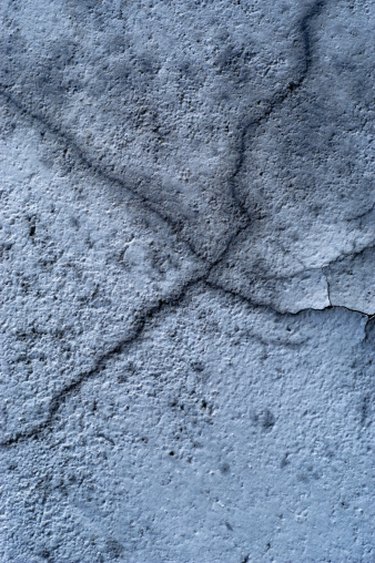Things You'll Need
Push broom
Wire brush
Chisel and hammer
Rag or mop
Mineral spirits
Pea gravel
Sand
Portland cement
Wheelbarrow or bucket
Cement adhesive or paste
Mason’s trowel

Concrete is more than just cement and water mixed together. For thick installations, concrete actually consists of small pieces of stone, commonly pea gravel, pebbles the approximate size of (large) peas that comprise the majority of the concrete surface. When pea gravel concrete becomes exceptionally cracked, faded or worn down, resurfacing is a task that can restore the concrete to its best look without professional help.
Step 1
Run over the entire concrete surface with a push broom to remove all loose dust and debris. If your concrete has cracks or gaps, brush out the dirt and silt with a wire brush to remove all excess debris. Chisel off any loose pieces. You must remove all dust and loose concrete before resurfacing.
Video of the Day
Step 2
Wipe down the concrete surface with a rag or mop dampened in mineral spirits. This solvent cleaner will remove grease, oil and wax that can ruin the way the repair work clings to the original concrete.
Step 3
Rinse the surface well with water to remove residual cleaner. Allow the surface to air-dry until it is moist but not wet before continuing.
Step 4
Mix three parts pea gravel, two parts sand and 1 ½ parts portland cement into a wheelbarrow or bucket. Add enough water to make the mixture the consistency of thick peanut butter. This is your resurfacing material.
Step 5
Spread a thin layer of cement adhesive or cement paste over the entire concrete surface. These products usually come with an applicator; if not you can use a paintbrush, roller or trowel. The adhesive will fill in some of the gaps in the old concrete and ensure that the resurfacing material sticks in place until it dries.
Step 6
Spread a 1- to 1 ½-inch-thick layer of the resurfacing material over the concrete surface. Use a mason's trowel to create a flat, even layer of material on top of the old concrete. You may need to add more material to some places than others, if you need to fill in gaps or cracks within the surface. Observe the material for the first half hour or so after applying and fill in any low points as necessary. Allow the material to dry undisturbed for at least 48 hours. Depending on the temperature and humidity in the area, it could take up to a week for the new surface to cure completely.
Tip
For best results, work on a cloudy day with little or no wind, in temperatures ranging between 50 and 60 degrees Fahrenheit. This will ensure that the resurfacing mixture dries slowly for a stronger hold.
You should only add pea gravel to the resurfacing mixture if you need to apply a layer of repair work more than 1 inch thick. Otherwise, mix three parts sand to one part portland cement, with enough water to make the consistency similar to mortar or peanut butter.
Consider applying a concrete sealant after the repair work is dry to protect the surface from moisture, staining and damage.
Warning
Cement is extremely caustic and can cause severe burns or other injuries if allowed to contact skin. Wear protective gloves, goggles and long clothes when working with cement or concrete material, and wash any material off your skin immediately.
Video of the Day